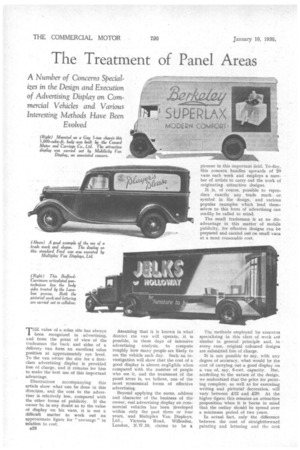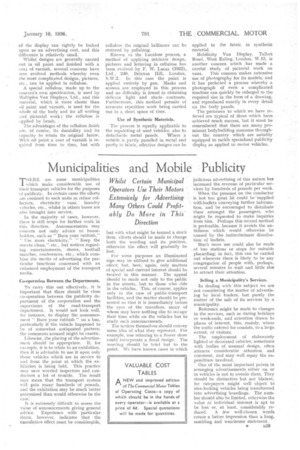The Treatment of Panel Areas
Page 46

Page 47

If you've noticed an error in this article please click here to report it so we can fix it.
A Number of Concerns Specializes in the Design and Execution of Advertising Display on Commercial Vehicles and Various Interesting Methods Have Been THE value of a solus site has always been recognized in advertising, and from the point of view of the tradesman the back and sides of a delivery van form an excellent solus position at approximately eye level. To the van owner the site for a firstclass advertising display is provided free of charge, and it remains for him to make the best use of this important advantage.
Illustrations accompanying this article show what can be done in this direction, and the cost to the advertiser is relatively low, compared with the other forms of publicity. If the owner be in any doubt as to the value of display on his vans, it is not a difficult matter to work out an approximate figure for " coverage " in relation to cost.
a28 Assuming that it is known in what district the van will operate, it is possible, in these days of intensive advertising analysis, to compute roughly how many people are likely to see the vehicle each day. Such an investigation will show that the cost of a good display is almost negligible when compared with the number of people who see it, and the treatment of the panel areas is, we believe, one of the most economical forms of effective advertising.
Beyond applying the name, address and character of the business of the owner, real advertising display on commercial vehicles has been developed within only the past three or four years, and Multiplex Van Displays. Ltd., Victoria Road, Willesden, London, N.W.10, claims to be a The methods employed by concerns specializing in this class of work are similar in general principle and, in • every case, original coloured designs are submitted free of charge.
It is not possible to say, with any degree of accuracy, what would be the cost of carrying out a good display on a van of, say, S-cwt. capacity. But, according to the nature of the design, we understand that the price for painting complete, as well as for executing writing and pictorial decoration, will vary between £12 and £20. At the higher figure this remains an attractive proposition when it is borne in mind that the outlay should be spread over a minimum period of two years.
In actual fact, only the difference between the cost of straightforward painting and lettering and the cost of the display can rightly he looked upon as an advertising cost, and this diffeience is relatively small.
Whilst designs are generally carried out in oil paint and finished with a coat of varnish, several concerns have now evolved methods whereby even the most complicated designs, pictures, etc., can be applied in cellulose.
A special cellulose; made up to the concern's own specification, is used by Multiplex Van-Displays; Ltd., and this material, which is more elastic than oil paint and varnish, is used for the whole of the body and for all writing pictorial work ; the cellulose is .ipplied by brush.
The advantages of the cellulose finish are, of -Course, its durability and its capacity to retain its original lustre. With oil paint a coat of varnish is recluired from time to time, but with
cellulose the original brilliance can be restored by polishing.
Known as the Lucalose process, a method of applying intricate design, pictures and lettering in cellulose has been evolved by F. W. Lucas (1922), Ltd., 240, Brixton Hill, London, S.W.2, In this case the paint is applied entirely by gun. Masks and screens are employed in this process and no difficulty is found in obtaining delicate light and shade contrasts. Furthermore, this method permits of accurate repetition work being carried out in a short space of time. .
Use of Synthetic Materials.
The process is equally applicable to the, repainting of used vehicles, also to detachable metal panels. Where a vehicle is partly panelled in metal and partly in fabric, effective designs can be applied to the fabric hi synthetic material.
Mobllicity Van Display, Talbot Road, West Ealing. London, W.1:4, is another concern which has made a careful study of pictorial work on vans. This concern makes extensive use of photography for its models, and it has perfected a process whereby a photograph of even a complicated machine can quickly be enlarged to the required size in the form of a drawing, and reproduced exactly in every detail on the body panels.
The processes to which we have re-. ferred are typical of those which have achieved much success, but it must be remembered that there are many prominent bodybuilding concerns throughout the country which are suitably equipped to tackle specialized publicity display as applied to motor vehicles.




































































































